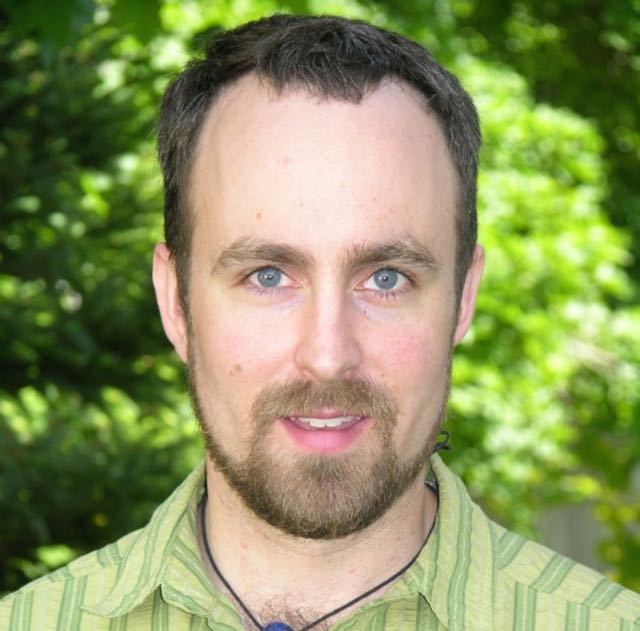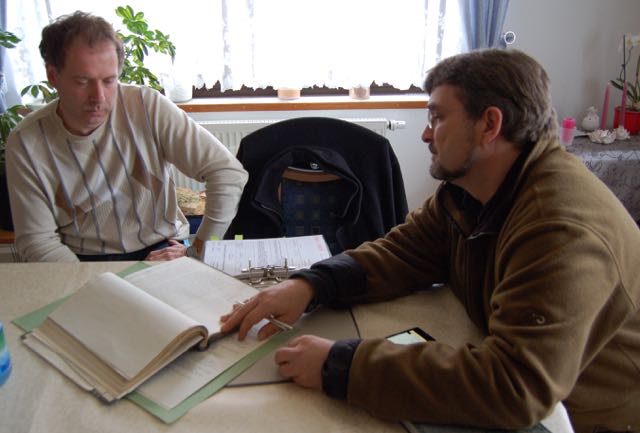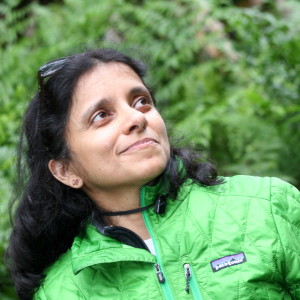
Starting in the early 1970s, two German boys—one from the East, one from the West—with binoculars around their necks spent their teenage years pacing either side of the insurmountable Iron Curtain, the “death zone,” looking for birds. Today, the former pen pals are striving to transform the no-man’s-land into a Green Belt across Europe. Theirs is a tale of two nature lovers overcoming physical and ideological barriers to rewild a domesticated continent.
To get the account right, journalist Phil McKenna literally walked into a minefield. Getting the piece into print wasn’t easy either. “28,000 miles, 8 countries, 4 editors, 3 publishers & 2 years later, the story about 2 boys and a wall is live,” he tweeted the day his article was published. “Life in the Death Zone” appeared at NOVA Next on February 18, 2015, and was co-published the same day as “The Boys Who Loved Birds” at The Big Roundtable. Here, McKenna tells Vijee Venkatraman the story behind the story. (This interview has been edited for length and clarity.)
How did you find this epic story of friends on two sides of the Iron Curtain?
Four years after the fall of the Berlin Wall, I was an exchange student in Hungary and used to visit a friend’s family in Romania. Vehicles waited in line for hours to get clearance at the border while soldiers with Kalashnikov rifles kept watch over a no-man’s-land, the ravine that ran beneath us. This was in 1993, between two former Eastern bloc nations. So I had a sense of how harrowing the border-crossing experience must’ve been for a young German when the wall was still up.
I read about BUND, the organization behind the Green Belt in Germany. At 17, Kai Frobel had documented sightings of rare birds in the no-man’s-land between East and West Germany, alerting biologists to the diversity of life in the Iron Curtain’s “death zone.” Today, he is acknowledged as the father of the Green Belt. In the BBC video “Iron Curtain, Ribbon of Life,” Kai recounts his story. I read of his childhood friendship with Gunter Berwing, a young East German who was also interested in birds. But it looked like the story of the former pen pals, now working together on this conservation project, was much deeper and richer than the short accounts suggested.Then, I read a [2004] clip in Outside magazine about an ambitious new initiative, originating in Germany, which could transform the former no-man’s-land running across Europe into an eco-corridor. They said to give it time. In 2012, I heard about this three-week fellowship [the McCloy Fellowship] offered by the American Council on Germany. It would allow me to report from Europe, so I decided to see what was up with the European Green Belt.
How did you start the reporting process?
First, I got in touch with Kai. My wife, who is my first reader and editor, became my translator as well. She spoke to Gunter who said he would follow Kai’s lead, but it seemed he was not that interested in talking about his past.
In February 2013, as a McCloy Fellow, I attended a conference on the European Green Belt in Vienna. I traveled in Central Europe to see the state of the eco-corridor, which was what my story was going to be about. I met Kai in person.
Now, when someone has told a story umpteen times, they are often in autopilot mode. But Kai mentioned something interesting. As a teen, one afternoon, he had snuck into the no-man’s-land when the guards weren’t looking. This foray into the wilderness inspired his later vision of rewilding a continent. Here was a pivotal moment in the story, a fresh image. I had to return for more.
Later in 2013, a [National Association of Science Writers] travel fellowship took me to the World Conference of Science Journalists [WCSJ] in Finland, and back to Germany. Kai and I drove to Hassenberg, the village where he grew up. He hadn’t visited in years now. When we were near his childhood home, he asked, “Do you need to go in?” I tried to be nonchalant and say, “Not really.” But he pulled up, and was soon knocking at the door. The people who lived there let us in. From the bedroom window, we could see Gunter’s Aunt Nelli’s house—the person who’d been instrumental in bringing him and Gunter together. Older people like Nelli who lived in West Germany but had family in East Germany could apply for a one-day pass and visit their relatives from time to time. Rooks, a type of crow, didn’t have such restrictions—they flew across the border every day in winter. Gunter asked his aunt what the rooks that roosted in the hills above his home did in the West all day. She didn’t know the answer, but put him in touch with Kai, the young birder in her village. Soon, the boys became pen pals.
The old haunts drew out old memories. For instance, we went to a place near the border where Kai had observed nightjars as a teen. Those birds nested near a tunnel, which the Stasi used to smuggle spies across, so the guards would look at Kai with suspicion whenever he walked by. Now, the tunnel is gone—there’s a narrow country lane instead. In Sonneberg, Gunter’s hometown, where he lives to this day, his mother received us warmly, but Gunter was nowhere to be seen.

And despite all this on-site reporting, you had not even pitched the story yet?
Correct. From the venue of the WCSJ, I sent my story proposal to a publication I had worked with before. Within a week, they commissioned the story. I could return to Germany. Of course, I had to speak to Gunter, the other protagonist, this time.
How hard was it to break the wall Gunter had put up around him?
My third trip to Germany, in February 2014, was timed so that I could attend a talk Kai was giving in Sonneberg. Realizing my genuine interest in the story, he must’ve conveyed to Gunter: “Phil’s OK.” So, he agreed to meet me and show me the Stasi dossiers that the East Germans had kept on Gunter’s activities and correspondence with Kai, which included the very reports that had denied him a college education. But I would only get half a day with him—that was it.
That afternoon Kai, the interpreter, was also an interviewee. What was their first meeting like? I asked. They fed off each other’s responses and I got fantastic details. And we looked at the old files, which included copies of the letters the friends had exchanged. Gunter seemed reluctant to talk, but once he started he had all kinds of things to say: As a young man, he once had a chance to defect but didn’t because he had a girlfriend (now his wife); and in five years of observing rooks, they defecated on him only once; and though he’d felt trapped by the border, unlike Kai, he never had nightmares about it. Next morning, I asked Kai about those nightmares, and got another great image for the story.
How did you organize all your notes?
I’d recorded part of my tour with Kai using my phone’s video camera but mostly took notes either on a lightweight, portable keyboard designed for small children or in an old school notebook. I also took tons of photos. Once I got home, I either transcribed or uploaded my notes into Word documents.
How did you decide on the structure of the story?
I’d interviewed many people connected to the Green Belt. As I mention in the story, the eco-corridor links 40 national parks across 24 four countries like a “string of pearls.” I’d visited six of them. In the north, I went to the pristine Norway-Russia border, and to Albania down south, where things were not going so well for the forest or its creatures.
The key scenes were set in Germany, but I had notes from other parts of Europe. Of course, I did not want readers to get whiplash or be buffeted around thinking “Where am I in time and place?” Some things had to go: I’d cross-country skied with the mayor of a Czech village to the edge of a forest where the lynx had made a comeback; I’d interviewed an 85-year-old Finnish biologist who saw a dark strip running along the Finnish-Soviet border from early satellite images, which suggested that the no-man’s land harbored the region’s last old growth forest, which could be home to greater biodiversity; [I had a] scene from a café in the Albanian capital where there were caged bears; and so on.
In the end, I kept the focus on Gunter and Kai.
You killed some darlings, as the saying goes, and banged out a draft. What came next?
I turned in my draft in March 2014. It went through three rounds of edits, but that summer a new executive editor came on board [at the magazine I’d sold the story to]. Word was he didn’t like some stories his predecessor had commissioned. An editor was still working on this project but it was not advancing the way I felt it needed to. I sensed that we were not going to make the anniversary of the fall of the Berlin Wall. Once, in the past, an editor sat on a story of mine for an entire year before killing it. Reselling it was tough. So, I decided to be proactive. I wanted a decision. I got my kill fee.
By September, I re-pitched my story to 24 other publications. I was upfront about what I was doing. I typically included a brief note at the top of my email that said: “Note, due to time constraints I am pitching this piece to multiple publications simultaneously.” Most editors were really good about getting back to me very quickly.
One outlet wanted it substantially shortened. Two others were willing to keep it longform: One was The Big Roundtable, whose forte is narrative; the other was NOVA Next, whose strong suit is science. They decided to collaborate. I think both felt it would be a good opportunity to reach readers beyond their usual audience. Tim De Chant of NOVA Next, in particular, was very open to trying something quite different, a story that was significantly longer and less science-focused than what they typically run.
Three editors were working on the piece now. We whittled down pages of scenes from outside Germany to a few paragraphs. Only one national park, between Bonn and Berlin, made the cut. The NOVA editor wanted additional reporting on the science, but it was largely a matter of putting back things, which another editor had cut previously.
What are some lessons you learned from the experience?
One lesson would be picking one story and sticking to it instead of jumping all over the place. Turns out, I got roughly ninety percent of the key scenes that one afternoon, and evening, I spent with Gunter and Kai.
So, could I have forgone some of the other trips? No. While the vast majority of my reporting didn’t make it into my story, much of it did help shape what I wrote. For example, on my first trip to Europe I met with a biologist from a German organization working in the Balkans. From him, I learned just how bad the situation was in Albania. And every trip meant an additional opportunity to meet with Kai and, eventually, Gunter.
Another big lesson from this experience was patience. Early in the process, I had some indication that things were heading in the right direction. When I saw Kai for the last time, he dropped me off at a natural history museum. I was there to pick up a copy of one of his earliest research publications. He thanked me for reminding him of things he’d forgotten from the past, and for helping him learn things he’d not known before. Then, he hugged me. In case, you don’t know: Germans are not Californians—they don’t do such things easily. I told myself if I could write the piece as well as I’d reported it, it would be a great story.
There were setbacks, but I just had to be patient. Like Gunter told Kai the first time they met: Es geht seinen Gang. It takes its course.
A glimpse behind the scenes:

Vijee Venkatraman is a freelance writer based in Boston. She is a graduate of Boston University’s Science Journalism program. She writes for Science Careers, Boston Globe, Christian Science Monitor, and others. Follow her on Twitter @vijeescijo.


